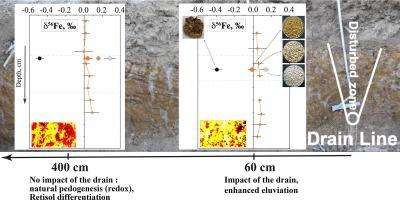Our official English website, www.x-mol.net, welcomes your feedback! (Note: you will need to create a separate account there.)
Evolution of Retisol impacted by artificial drainage: What can we learn from stable Fe isotope ratios?
Geoderma ( IF 6.1 ) Pub Date : 2021-02-01 , DOI: 10.1016/j.geoderma.2020.114771 Z. Fekiacova , D. Montagne , A. Duvivier , A. Guihou , P. Deschamps , S. Cornu
Geoderma ( IF 6.1 ) Pub Date : 2021-02-01 , DOI: 10.1016/j.geoderma.2020.114771 Z. Fekiacova , D. Montagne , A. Duvivier , A. Guihou , P. Deschamps , S. Cornu

|
Abstract Iron oxides are one of the most reactive mineral phases in soils. As a consequence, their transformations can considerably affect the dynamics of the adsorbed elements and of the associated soil ecosystem services. Understanding the dynamics of Fe oxides in soils is therefore a key issue for the evolution of soil and associated ecosystem services. A potentially powerful tool to study the transformations of Fe-oxides in soil is stable Fe isotopes. However, there are still important gaps in our knowledge of Fe isotope fractionations. In order to examine the Fe isotope fractionations related to each process occurring in soils, we focused on a drainage-influenced sequence of Retisols, a soil type characterized by clay translocation and subsequent degradation by redox processes inducing a strong spatial Fe segregation in contrasted soil volumes. We combined the isotopic approach at the scale of a bulk horizon and at the scale of the different soil volumes, with mineralogical analyses and mass balance calculations in order to investigate the consequences of the drainage on Fe isotope fractionation. We showed that while there were no Fe isotope fractionations at the profile scale, Fe isotopic signatures varied significantly among soil volumes (δ56Fe values from −0.49 ± 0.05 to 0.29 ± 0.06‰). These variations suggest that redox processes are the main mechanisms responsible for the Fe redistribution among the volumes, and particularly that Fe accumulation during Mn oxide precipitation makes a significant contribution to Fe isotopic fractionation, during these Retisol differentiation. In contrast, drainage-induced eluviation does not result in further Fe isotope fractionations in soil volumes in these Retisols. The isotopic signatures of the different mineral phases present in the volumes were calculated using the mass balance approach and suggest that the iron oxides (goethite, ferrihydrite) have δ56Fe values close to 0‰, while the clay minerals are enriched in heavy Fe isotopes and the Mn oxides in light Fe isotopes. This study provides insight into the dynamics of Fe minerals in hydromorphic soils and offers a new perspective on stable Fe isotope fractionation in soils.
中文翻译:

受人工排水影响的 Retisol 的演变:我们可以从稳定的 Fe 同位素比率中学到什么?
摘要 氧化铁是土壤中活性最强的矿物相之一。因此,它们的转变会显着影响吸附元素和相关土壤生态系统服务的动态。因此,了解土壤中 Fe 氧化物的动态是土壤和相关生态系统服务演变的关键问题。研究土壤中铁氧化物转化的潜在有力工具是稳定的铁同位素。然而,我们对 Fe 同位素分馏的了解仍然存在重大差距。为了检查与土壤中发生的每个过程相关的 Fe 同位素分馏,我们专注于受排水影响的 Retisols 序列,一种土壤类型,其特征是粘土易位,随后通过氧化还原过程降解,导致对比土壤体积中强烈的空间 Fe 分离。我们将大范围尺度和不同土壤体积尺度的同位素方法与矿物学分析和质量平衡计算相结合,以研究排水对 Fe 同位素分馏的影响。我们表明,虽然在剖面尺度上没有 Fe 同位素分馏,但 Fe 同位素特征在土壤体积之间存在显着差异(δ56Fe 值从 -0.49 ± 0.05 到 0.29 ± 0.06‰)。这些变化表明氧化还原过程是负责 Fe 在体积之间重新分布的主要机制,尤其是在这些 Retisol 分化过程中,Mn 氧化物沉淀过程中的 Fe 积累对 Fe 同位素分馏有显着贡献。相比之下,排水诱导的淋洗不会导致这些 Retisols 中土壤体积中的铁同位素进一步分馏。使用质量平衡方法计算了体积中存在的不同矿物相的同位素特征,并表明铁氧化物(针铁矿、水铁矿)的 δ56Fe 值接近 0‰,而粘土矿物富含重 Fe 同位素和轻铁同位素中的锰氧化物。这项研究提供了对水形土壤中铁矿物动力学的深入了解,并为土壤中稳定的铁同位素分馏提供了新的视角。排水诱导的淋溶不会导致这些 Retisols 中土壤体积中的铁同位素进一步分离。使用质量平衡方法计算了体积中存在的不同矿物相的同位素特征,并表明铁氧化物(针铁矿、水铁矿)的 δ56Fe 值接近 0‰,而粘土矿物富含重 Fe 同位素和轻铁同位素中的锰氧化物。这项研究提供了对水形土壤中铁矿物动力学的深入了解,并为土壤中稳定的铁同位素分馏提供了新的视角。排水诱导的淋溶不会导致这些 Retisols 中土壤体积中的铁同位素进一步分离。使用质量平衡方法计算了体积中存在的不同矿物相的同位素特征,并表明铁氧化物(针铁矿、水铁矿)的 δ56Fe 值接近 0‰,而粘土矿物富含重 Fe 同位素和轻铁同位素中的锰氧化物。这项研究提供了对水形土壤中铁矿物动力学的深入了解,并为土壤中稳定的铁同位素分馏提供了新的视角。水铁矿)的δ56Fe值接近0‰,而粘土矿物富含重铁同位素和轻铁同位素中的锰氧化物。这项研究提供了对水形土壤中铁矿物动力学的深入了解,并为土壤中稳定的铁同位素分馏提供了新的视角。水铁矿)的δ56Fe值接近0‰,而粘土矿物富含重铁同位素和轻铁同位素中的锰氧化物。这项研究提供了对水形土壤中铁矿物动力学的深入了解,并为土壤中稳定的铁同位素分馏提供了新的视角。
更新日期:2021-02-01
中文翻译:

受人工排水影响的 Retisol 的演变:我们可以从稳定的 Fe 同位素比率中学到什么?
摘要 氧化铁是土壤中活性最强的矿物相之一。因此,它们的转变会显着影响吸附元素和相关土壤生态系统服务的动态。因此,了解土壤中 Fe 氧化物的动态是土壤和相关生态系统服务演变的关键问题。研究土壤中铁氧化物转化的潜在有力工具是稳定的铁同位素。然而,我们对 Fe 同位素分馏的了解仍然存在重大差距。为了检查与土壤中发生的每个过程相关的 Fe 同位素分馏,我们专注于受排水影响的 Retisols 序列,一种土壤类型,其特征是粘土易位,随后通过氧化还原过程降解,导致对比土壤体积中强烈的空间 Fe 分离。我们将大范围尺度和不同土壤体积尺度的同位素方法与矿物学分析和质量平衡计算相结合,以研究排水对 Fe 同位素分馏的影响。我们表明,虽然在剖面尺度上没有 Fe 同位素分馏,但 Fe 同位素特征在土壤体积之间存在显着差异(δ56Fe 值从 -0.49 ± 0.05 到 0.29 ± 0.06‰)。这些变化表明氧化还原过程是负责 Fe 在体积之间重新分布的主要机制,尤其是在这些 Retisol 分化过程中,Mn 氧化物沉淀过程中的 Fe 积累对 Fe 同位素分馏有显着贡献。相比之下,排水诱导的淋洗不会导致这些 Retisols 中土壤体积中的铁同位素进一步分馏。使用质量平衡方法计算了体积中存在的不同矿物相的同位素特征,并表明铁氧化物(针铁矿、水铁矿)的 δ56Fe 值接近 0‰,而粘土矿物富含重 Fe 同位素和轻铁同位素中的锰氧化物。这项研究提供了对水形土壤中铁矿物动力学的深入了解,并为土壤中稳定的铁同位素分馏提供了新的视角。排水诱导的淋溶不会导致这些 Retisols 中土壤体积中的铁同位素进一步分离。使用质量平衡方法计算了体积中存在的不同矿物相的同位素特征,并表明铁氧化物(针铁矿、水铁矿)的 δ56Fe 值接近 0‰,而粘土矿物富含重 Fe 同位素和轻铁同位素中的锰氧化物。这项研究提供了对水形土壤中铁矿物动力学的深入了解,并为土壤中稳定的铁同位素分馏提供了新的视角。排水诱导的淋溶不会导致这些 Retisols 中土壤体积中的铁同位素进一步分离。使用质量平衡方法计算了体积中存在的不同矿物相的同位素特征,并表明铁氧化物(针铁矿、水铁矿)的 δ56Fe 值接近 0‰,而粘土矿物富含重 Fe 同位素和轻铁同位素中的锰氧化物。这项研究提供了对水形土壤中铁矿物动力学的深入了解,并为土壤中稳定的铁同位素分馏提供了新的视角。水铁矿)的δ56Fe值接近0‰,而粘土矿物富含重铁同位素和轻铁同位素中的锰氧化物。这项研究提供了对水形土壤中铁矿物动力学的深入了解,并为土壤中稳定的铁同位素分馏提供了新的视角。水铁矿)的δ56Fe值接近0‰,而粘土矿物富含重铁同位素和轻铁同位素中的锰氧化物。这项研究提供了对水形土壤中铁矿物动力学的深入了解,并为土壤中稳定的铁同位素分馏提供了新的视角。

























 京公网安备 11010802027423号
京公网安备 11010802027423号